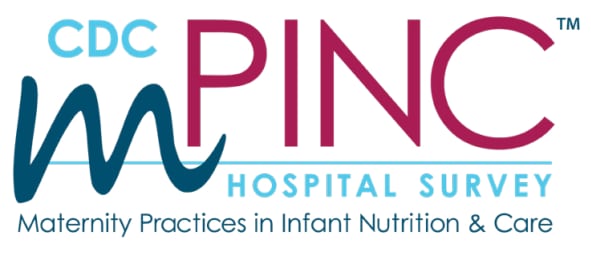Overview
Maternity Practices in Infant Nutrition and Care (mPINC™)

The 2024 mPINC state reports summarize the strength of policies and practices that support breastfeeding in hospitals in each state and territory, as well as the areas that could be improved. These reports identify opportunities for states to better protect, promote, and support breastfeeding mothers and infants.
Select a Location
Data were not reported for District of Columbia in 2024 due to small sample size.
Download Instructions
- To unzip a single file or folder, open the zipped folder, then drag the file or folder from the zipped folder to a new location.
- To unzip all the contents of the zipped folder, press and hold (or right-click) the folder, select Extract All, and then follow the instructions.
NOTE:
About mPINC
What is mPINC?
mPINC is CDC’s national survey of Maternity Practices in Infant Nutrition and Care. The survey measures practices and policies in maternity care that support breastfeeding. Use mPINC data to bring together partners, identify gaps, celebrate achievements, and prioritize next steps.
What does mPINC measure?
The survey measures practices and policies that impact newborn feeding, feeding education, staff training and skills, and discharge support.
Who is included in mPINC surveys?
About every two years CDC invites all hospitals with maternity services in the U.S. and territories to participate.
Questions about the mPINC survey?
About the Maternity Practices in Infant Nutrition and Care (mPINC) trademark: The mPINC trademark (word and logo) are owned by the U.S. Department of Health and Human Services in the United States. An organization's participation in CDC's mPINC survey does not imply endorsement by the U.S. Department of Health and Human Services or the Centers for Disease Control and Prevention.
Breastfeeding Data
stateName - 2024 Report
mPINC Results

Key points
- stateName Total Score*: stateTotal
- National Total Score*: 82
Implementing best practices and policies in maternity care help to improve breastfeeding outcomes. Use the stateName mPINC data to bring together partners, identify gaps, celebrate achievements, and prioritize next steps.
Responding Hospitals
In 2024, eligibleHospitals eligible hospitals in stateName participated (hospitalPercentage).Immediate Postpartum Care
National Subscore: 84 stateName Subscore: ipcState
| Measure | stateName Hospitals with Ideal Response |
|---|---|
| Newborns remain in uninterrupted skin-to-skin contact for at least 1 hour or until breastfed (vaginal delivery) | ipcOne |
| Newborns remain in uninterrupted skin-to-skin contact for at least 1 hour or until breastfed (cesarean delivery) | ipcTwo |
| Mother-infant dyads are NOT separated before rooming-in (vaginal delivery) | ipcThree |
| Newborns are monitored continuously for the first 2 hours after birth | ipcFour |
Rooming-In
National Subscore: 77 stateName Subscore: rnState
| Measure | stateName Hospitals with Ideal Response |
|---|---|
| Mother-infant dyads are rooming-in 24 hours/day | rnOne |
| Routine newborn exams, procedures, and care occur in the mother’s room | rnTwo |
| Hospital has a protocol requiring frequent observations of high-risk mother-infant dyads | rnThree |
Feeding Practices
National Subscore: 80 stateName Subscore: fpState
| Measure | stateName Hospitals with Ideal Response |
|---|---|
| Few breastfeeding newborns receive infant formula | fpOne |
| Hospital does NOT perform routine blood glucose monitoring on newborns not at risk for hypoglycemia | fpTwo |
| When breastfeeding mothers request infant formula, staff counsel them about possible consequences | fpThree |
Feeding Education and Support
National Subscore: 95 stateName Subscore: fesState
| Measure | stateName Hospitals with Ideal Response |
|---|---|
| Mothers whose newborns are fed formula are taught feeding techniques and how to safely prepare/feed formula | fesOne |
| Breastfeeding mothers are taught/shown how to recognize/respond to feeding cues, to breastfeed on-demand, and to understand the risks of artificial nipples/pacifiers | fesTwo |
| Breastfeeding mothers are taught/shown how to position and latch their newborn, assess effective breastfeeding, and hand express milk | fesThree |
Discharge Support
National Subscore: 78 stateName Subscore: dsState
| Measure | stateName Hospitals with Ideal Response |
|---|---|
| Discharge criteria for breastfeeding newborns requires direct observation of at least 1 effective feeding at the breast within 8 hours of discharge | dsOne |
| Discharge criteria for breastfeeding newborns requires scheduling of the first follow-up with a health care provider | dsTwo |
| Hospital’s discharge support to breastfeeding mothers includes in-person follow-up visits/appointments, personalized phone calls, or formalized, coordinated referrals to lactation providers | dsThree |
| Hospital does NOT give mothers any of these items as gifts or free samples: infant formula; feeding bottles/nipples, nipple shields, or pacifiers; coupons, discounts, or educational materials from companies that make/sell infant formula/feeding products | dsFour |
Institutional Management
National Subscore: 77 stateName Subscore: imState
| Measure | stateName Hospitals with Ideal Response |
|---|---|
| Nurses are required to demonstrate competency in assessing breastfeeding (milk transfer & maternal pain), assisting with breastfeeding (positioning & latch), teaching hand expression & safe formula preparation/feeding, and demonstrating safe skin-to-skin practices | imOne |
| Hospital requires nurses to be formally assessed for clinical competency in breastfeeding support/lactation management | imTwo |
| Hospital records/tracks exclusive breastfeeding throughout the entire hospitalization | imThree |
| Hospital pays a fair market price for infant formula | imFour |
| Hospital has 100% of written policy elements§ | imFive |
*Scores range from 0 to 100, with 100 being the best possible score. The “Total Score” is an average of the subscores for the 6 domains.
§See the scoring algorithm for specific items at www.cdc.gov/breastfeeding-data/mpinc/scoring.html
Note:
The mPINC survey was redesigned in 2018. Results from the 2024 mPINC survey can be compared with results from 2018-2022 mPINC surveys.
Questions about the mPINC survey?
Visit www.cdc.gov/breastfeeding-data/mpinc/index.html to learn more.
Suggested Citation: Centers for Disease Control and Prevention. stateName 2024 Report, CDC Survey of Maternity Practices in Infant Nutrition and Care. Atlanta, GA. 2025
